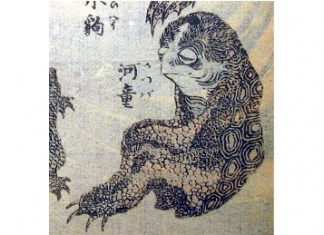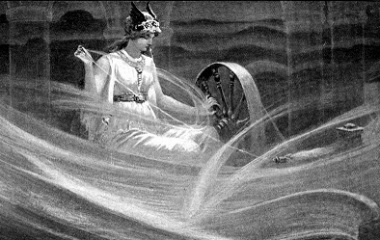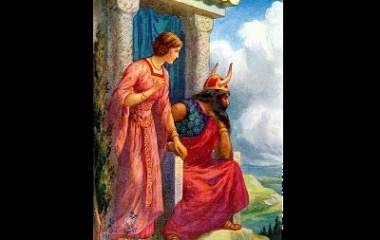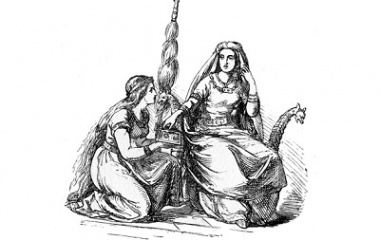- Pronunciation: FRIG
- Origin: Norse
- Role: Goddess
- Symbols: Spinning wheel and spindle, mistletoe
- Children: Balder, Hoor
- Husband: Oden
- Other Names: Frida, Frea, Frigga
Who Is Frigg?
Frigg wears many hats in Norse mythology. She is often described as “foremost among the goddesses,” and was the wife of Odin. She was the Queen of the Aesir and the goddess of the sky. She was also known as the goddess of fertility, household, motherhood, love, marriage, and domestic arts. Some of these domains were also overseen by another Norse goddess named Freyja. In Norse mythology, Frigg’s primary roles were familial roles, mostly surrounding her husband and children.
Origins
Many scholars believe that Frigg may have originated in a common Germanic goddess. While there is no firm evidence to prove the hypothesis, there are many similarities, such as mythological features and their names, as well as locations associated with both of them. Whether Frigg has a link to other types of mythology or not, she played a very important role in Norse mythology.
Legends and Stories
The mythic representations of Frigg focus on her family life. While she was greatly blessed, she also faced terrible heartache, which would eventually serve as her legacy.
The Loss of a Son
The myth surrounding Frigg and her role as a mother is by far the most famous. She gave birth to a son named Balder, who was the light of her life. The entire world seemed to rejoice when he was born and she was dedicated to helping her son grow. She was also incredibly protective. This instinct became stronger when Balder had a dream that predicted his own death.
Frigg went around to every living thing in the entire world and demanded that her son would not be harmed. She was unable to demand protection from the mistletoe, which seemed insignificant at the time.
With time, the gods made up a game involving Balder. They would throw anything they could find at him and watch the objects bounce off him, never causing a bruise or simple scratch. Balder was never hurt, no matter the size or weight of the item.
This pastime continued until the day that Loki gave a dart made from mistletoe to Hoor, Balder’s twin brother, who also happened to be blind. Loki told Hoor that he would help him play the game with Balder. With Loki’s assistance, Hoor threw the dart at his brother. Instead of it bouncing off of him like every other living thing on earth, it pierced his heart and killed him instantly.
When Frigg heard of her son’s passing, she fell to the ground in despair. After the initial shock, she went to work trying to alter Balder’s fate. She sent Hermodr to the Underworld where there was an attempt to ransom Balder’s soul. The Queen of the Underworld, Hel, agreed to release Frigg’s son, but only if all living things would weep for him.
Frigg set out right away, asking every living thing in the world if they would weep for her lost son. They all agreed until Frigg approached the last living thing on the planet, a giantess with the name Thokk. She refused Frigg’s request to weep and said, “Living or dead, I loved not the churl’s son. Let Hel hold to that she hath!” Many interpreters of Norse mythology believe that this giantess was actually Loki in disguise. Either way, this cursed Balder to the Underworld forever.
Frigg’s Switch
While Frigg was believed to have been an honorable wife, she did take hold of an opportunity to outsmart her husband and end a conflict between outsiders. Odin was known for being incredibly strong-willed but in this myth, Frigg found a way past this. A conflict had broken out between two Germanic tribes, known as the Vandals and the Winnilers. Odin favored the Vandals, while Frigg supported the Winnilers.
One evening, Frigg and Odin got into an argument of their own over the tribes. They each gave reasons supporting why their tribe of choice was right and why the other was wrong. Finally, Odin swore that whichever tribe he saw first thing in the morning, he would grant victory to. He did this knowing that the Vandals would be visible through the window on his side of the bed.
While Odin was sleeping, Frigg told the women of the Winniler tribe to reposition their hair so that it would appear as long beards. She also turned the bed so that her husband was facing in the opposite direction. When he woke, he was taken aback by what he saw. He asked Frigg who the “long-beards” were. He had been outsmarted but kept his promise and granted victory to the Winniler tribe and even eventually admitted that Frigg’s choice was correct.
Family
Frigg was married to Odin and they had a family together. Because of his untimely death, Balder is the first child many associate with the goddess.
Odin
Odin was one of the most popular gods in Norse mythology. He was often associated with royalty, death, healing, battles, poetry, sorcery and knowledge. He carried a spear named Gungnir and was often accompanied by animal companions, including two wolves named Geri and Freki, and two ravens named Muninn and Huginn.
Balder
Balder was a god with a central role in Norse mythology. He was the god of love, peace, forgiveness and justice. He was the second son of Frigg and Odin and had a twin brother named Hoor, who ultimately caused his demise.
Appearance
Frigg is mostly depicted as a beautiful and strong spirited woman. In many pictures, she is shown with her husband Odin, paying tribute to her strong role as a wife in Norse mythology. She is often pictured against soft and beautiful backgrounds, which seem to symbolize her calming nature.
Symbology
Frigg represents family. She is known as a source of nurturing, patient and devoted love. Even in situations where fate is already set, such as in her son’s untimely death, Frigg still did everything that she could to alter fate. Frigg’s main symbols include the full moon, the sky, the spinning wheel and spindle, mistletoe and silver, many of which are shown in artistic representations of the goddess.











well it only has a little info
no it had lots this helped me with my homework
Thanks helped me with my project.
thanks for the information,i managed to do my homework!!!!!!!
I hope i get a good mark
the pictures are cool though
not very informational. need more than that to do my work. though i must admit that info was quite cool.
Very, very informative. Thanks